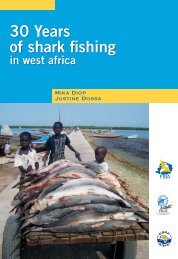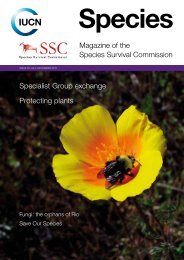Kyne & Simpfendorfer.. - Shark Specialist Group
Kyne & Simpfendorfer.. - Shark Specialist Group
Kyne & Simpfendorfer.. - Shark Specialist Group
Create successful ePaper yourself
Turn your PDF publications into a flip-book with our unique Google optimized e-Paper software.
Ebert and Davis 2007). These are the only skates for which this has been observed. The big<br />
skate can carry 2–7 embryos per egg case, with an average of 3–4 (Hitz 1964).<br />
There have been several ageing studies of rajid species, and while some are unvalidated and<br />
others preliminary, late maturity has again been demonstrated for the skates. Du Buit (1977)<br />
estimated a maximum age of 50 years for Dipturus batis while longevity of at least 20 years<br />
has been confirmed for A. radiata from skates tagged off Newfoundland (Templeman 1984).<br />
Ageing and growth estimates follow the general trend that larger species are slower growing<br />
and longer-lived than the smaller, faster-growing species (Sulikowski et al. 2005b).<br />
Ebert (2005) estimated the number of reproductive years for several skate species by<br />
considering age at first maturity and maximum observed age. Estimates for deepwater rajid<br />
skates ranged from 13 reproductive years for D. batis and D. innominatus (from Du Buit 1977<br />
and Francis et al. 2001, respectively), through 9 years for Leucoraja wallacei (from<br />
Walmsley-Hart et al. 1999), 6 years for L. naevus and D. pullopunctata (from Du Buit 1977<br />
and Walmsley-Hart et al. 1999, respectively), to 4 years for Raja rhina and D. nasutus (from<br />
Zeiner and Wolf 1993 and Francis et al. 2001, respectively) and 1–3 years for R. binoculata<br />
(from Zeiner and Wolf 1993) (Ebert 2005). Considering some more recent publications (see<br />
Table 2.15) similar estimations would give 3–6 reproductive years for female Amblyraja<br />
georgiana (from Francis and Ó Maolagáin 2005), 7 years for D. chilensis (from Licandeo et<br />
al. 2006) and 4 years for L. naevus (from Gallagher et al. 2004). The age estimations of<br />
McFarlane and King (2006) give considerably more reproductive years for both R. binoculata<br />
(17 years) and R. rhina (19 years) than those calculated from Zeiner and Wolf (1993).<br />
Estimates of annual and lifetime fecundity of rajid skates are highly variable between species.<br />
Annual fecundity has been estimated as 140 egg cases for R. clavata (shelf species; Holden<br />
1975), 90 for R. brachyura (shelf species; Holden et al. 1971) and L. naevus (Du Buit 1976),<br />
60 for R. montagui (shelf species; Holden et al. 1971), and 10–20 for A. radiata (Berestovskii<br />
1994). Ebert and Davis (2007) calculated that annual fecundity in R. binoculata may reach<br />
1260 based on assuming an average of 3.5 embryos per egg case, and egg-laying rates of 360<br />
egg cases per year in captivity (K. Lewand, pers. comm. in Ebert and Davis 2007). Ebert<br />
(2005) extrapolated the annual fecundity of R. clavata to calculate a lifetime fecundity of<br />
~980 egg cases based on the ageing estimates of Ryland and Ajayi (1984). For R. montagui,<br />
Ebert (2005) estimated annual production to be
















